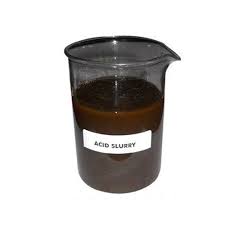
Acid slurry is a chemical compound that finds extensive applications in various industries, ranging from detergent manufacturing to oil refining. It is a versatile and valuable ingredient that plays a crucial role in different processes.
Acid slurry, also known as alkyl benzene sulphonate or ABS, is an anionic surfactant primarily composed of a mixture of linear alkyl benzene (LAB) and sulfuric acid. It is a brown viscous liquid with a characteristic odor. The primary purpose of acid slurry is to act as a surfactant, providing excellent foaming and cleaning properties. The length of the alkyl chain in the compound affects its detergent properties, making it suitable for different applications.
Applications of Acid Slurry
Detergent Industry: Acid slurry is a key ingredient in the production of synthetic detergents. It acts as a surfactant, providing excellent foaming and cleaning properties. Acid slurry-based detergents are widely used in laundry, dishwashing, and household cleaning products.
Textile Industry: Acid slurry finds applications in the textile industry as a wetting agent, facilitating the penetration of dyes and chemicals into fabrics during the dyeing and printing processes.
Leather Industry: Acid slurry is used in leather processing to remove impurities, soften the leather, and enhance its absorption capacity.
Oil Refining: Acid slurry is employed in the oil industry for the desalting of crude oil. It helps remove impurities, salts, and water from the oil, ensuring better quality and refining efficiency.
Agriculture: Acid slurry is used as an emulsifier and wetting agent in the formulation of agricultural pesticides and herbicides, facilitating their application and effectiveness.
Construction Industry: Acid slurry is utilized in the formulation of concrete additives and admixtures, aiding in the proper dispersion of cement particles and improving workability.
Acid slurry, also known as linear alkyl benzene sulfonic acid (LABSA), is a versatile chemical used in various industries such as detergent manufacturing, textiles, leather processing, and household cleaning products. With Nigeria's growing economy and increasing demand for cleaning and hygiene products, starting acid slurry production can be a lucrative business opportunity.
This article aims to provide a comprehensive guide on how to initiate acid slurry production in Nigeria, covering essential aspects from market analysis to the production process.
Market Analysis
Before venturing into any business, conducting thorough market research is crucial. In the case of acid slurry production, understanding the current market demand, potential customers, and competition is vital. Some key points to consider during the market analysis phase include:
Demand Assessment: Analyze the demand for acid slurry in various industries such as detergents, textiles, and personal care products. Understand the current market size, growth rate, and projected future demand to assess the business's viability.
Competitor Analysis: Identify existing acid slurry manufacturers in Nigeria and evaluate their production capacity, product quality, pricing strategies, and market share. Assessing their strengths and weaknesses will help you position your business effectively.
Target Customers: Determine the potential customers for your acid slurry products. This could include detergent manufacturers, small-scale soap producers, and other relevant industries. Identify their specific requirements, preferences, and purchasing patterns.
Business Plan and Legal Requirements
Developing a comprehensive business plan is essential for successfully launching and managing an acid slurry production unit. The following aspects should be covered in your business plan:
Production Capacity: Determine the desired production capacity based on market demand and available resources. This will help you estimate the required infrastructure, machinery, and raw materials.
Financial Analysis: Conduct a thorough financial analysis, including the cost of land, construction, machinery, labor, raw materials, and operational expenses. Assess the project's financial viability and develop a realistic budget.
Legal Requirements: Understand and comply with all legal requirements and regulations for establishing a chemical manufacturing unit in Nigeria. Obtain the necessary licenses, permits, and certifications from relevant authorities such as Standards Organization of Nigeria (SON).
Infrastructure and Machinery
Setting up the right infrastructure and acquiring suitable machinery are crucial for ensuring smooth operations and maintaining product quality. Consider the following factors:
Location: Choose a strategic location with good transportation facilities and access to raw materials. Proximity to target markets can also reduce logistics costs.
Production Facility: Construct a well-designed production facility that adheres to safety standards and facilitates efficient workflow. Ensure proper ventilation, drainage systems, waste management, and storage facilities for raw materials and finished products.
Machinery and Equipment: Invest in high-quality machinery and equipment required for acid slurry production. This may include reactors, mixers, pumps, filtration systems, and packaging machinery. Consult industry experts or hire experienced professionals for guidance on selecting the right machinery.
Raw Materials and Suppliers
Acid slurry production requires specific raw materials. Ensure a consistent and reliable supply chain by considering the following points:
Linear Alkyl Benzene (LAB): LAB is the primary raw material for acid slurry production. Establish a partnership with reliable suppliers or explore the possibility of setting up a LAB manufacturing unit if economically feasible.
Sulfur Trioxide (SO3): SO3 is used to sulfonate LAB and produce acid slurry. Identify trusted suppliers for this essential chemical.
Other Additives: Depending on your production process and desired product specifications, you may require additional additives such as catalysts, surfactants, and neutralizers. Identify reputable suppliers for these components as well.
Production Process
Understanding the acid slurry production process is crucial for maintaining product quality and optimizing efficiency. While the specific process may vary based on technology and equipment, the following steps provide a general overview:
Sulfonation: Combine LAB and SO3 in the sulfonation reactor under controlled conditions to form the sulfonic acid. This reaction occurs at elevated temperatures and requires accurate monitoring.
Neutralization: Neutralize the sulfonic acid by adding an alkaline solution, typically sodium hydroxide (NaOH), to adjust the pH. This step helps in removing excess acid and stabilizing the final product.
Drying: Remove excess water from the neutralized acid slurry by evaporation or drying methods, ensuring the desired moisture content is achieved.
Quality Control: Implement a robust quality control system to test samples at various stages of the production process. Conduct tests for parameters like pH, active matter content, color, and other specifications to ensure consistency and adherence to quality standards.
Marketing and Distribution
Once the production process is in place, it is essential to devise an effective marketing and distribution strategy to reach your target customers:
Branding and Packaging: Create a distinctive brand identity and design attractive packaging for your acid slurry products. Consult with graphic designers and packaging experts to develop appealing labels and containers.
Distribution Channels: Establish a distribution network by partnering with wholesalers, retailers, and distributors in the detergent and chemical industry. Explore both traditional and online distribution channels to expand your reach.
Promotion and Advertising: Utilize various marketing techniques such as digital marketing, trade shows, industry publications, and product demonstrations to create awareness and generate demand for your acid slurry products.
Environmental Impact
While acid slurry offers numerous benefits in various industries, it is essential to consider its potential environmental impact. Improper disposal of acid slurry can lead to water pollution, as it is non-biodegradable and can harm aquatic life. However, stringent regulations and industry practices ensure responsible handling, storage, and disposal of acid slurry waste.
In conclusion, starting acid slurry production in Nigeria requires careful planning, market analysis, and a strong understanding of the production process. By conducting comprehensive research, complying with legal requirements, investing in the right infrastructure and machinery, ensuring a consistent supply chain, and implementing effective marketing strategies, you can establish a successful acid slurry production unit.
Remember to prioritize product quality, customer satisfaction, and continuous improvement to stay competitive in the market and seize opportunities for growth in Nigeria's evolving economy.






















